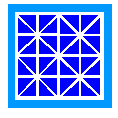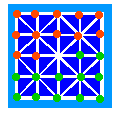 Alquerque
board
Alquerque
boardALQUERQUE
compiled by Modar Neznanich
HISTORY:
Alquerque is believed to have originated as an Arabic game. It is thought to have spread to Europe when the Moors invaded Spain.
RULES:
At the start of the game, each player places their twelve playing pieces on the board as shown in the diagram. A piece may be moved from one point to any adjacent point along an empty line, forwards, diagonally or sideways, but not backwards. If the adjacent point is occupied by an opponent's piece, you may jump over and capture said piece, providing there is an empty point immediately beyond it. If, having jumped and captured a piece, you land adjacent to another of your opponent's pieces with an empty point beyond it, you may jump again and capture a second piece. Any number of pieces may be captured in this manner in any one move.
If a piece can make a capture, that piece must do so, otherwise it is considered to be "huffed", and can be removed from the board by one's opponent. This is, if a piece that cannot make a capture is moved instead of one that can make a capture, the one that could capture but didn't is removed from the board.
However, if two or more pieces can make a capture on the same move, the pieces that did not capture are not removed from the board, provided a capture was made. If no capture was made, all pieces that could have captured are considered "huffed" and are removed from the board.
The game ends when one player loses all their pieces, cannot move a piece, or has all their pieces along the back row. The player with the most pieces left wins.
DIAGRAM:
 Alquerque
board
Alquerque
board
 Alquerque board set up (ones side in green, one
side in red)
Alquerque board set up (ones side in green, one
side in red)
©1998, 1999, 2000, 2001,
2002, 2003, 2004, 2005, 2006 Ron Knight
Baron Modar
Neznanich, OPel
Permission
to Print.
e-mail: modar@everestkc.net